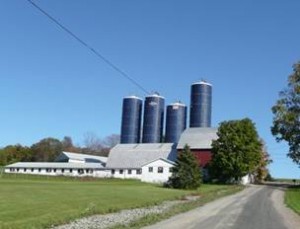Established in 1958, LCCD strives to provide for the conservation of soil and water resources through the control and prevention of soil erosion and conservation, restoration and planning of the county’s watersheds. LCCD serves the public as being a clearinghouse for information, erosion and sedimentation control, watershed conservation, environmental education and public outreach.
SOIL HEALTH PROGRAM
Since its inception, the Lackawanna County Conservation District’s Soil Health Program has changed in scope, but not in purpose. Our program objectives are to provide education, technical guidance, and funding assistance for no-till, cover crops, and other soil health practices. The District regularly hosts workshops and events to promote and highlight soil health. Upon request, soil testing and/or soil health analysis can be performed, at minimal or no cost, to determine what management changes may be necessary to improve soil health and decrease runoff into the Chesapeake Bay. Also, we have a 10′ Haybuster no-till seeder and a 5 Ton Stotzfus Redhawk Lime Spreader available for rental to plant hay seedings/cover crops and boost soil fertility with regular lime application. In order to further assist our farming community, we also have purchase a John Deere 7000, 4-row, no-till corn planter. This will allow us to further serve our County farmers while furthering our no-till goals! Last, but certainly not least, we utilize programs such as the Lackawanna County Soil Health Enhancement Program and REAP Tax Credit program to provide cost-share funding for producers.
CHESAPEAKE BAY PROGRAM
 The Lackawanna Conservation District has participated in the Chesapeake Bay Program since the late 1980’s. Over this time, numerous landowners have volunteered to identify non-point source pollution and addressed these problems with Best Management Practices (BMP’s). These BMP’s included barnyard improvement and stabilization, manure storage, grazing systems, stream crossings, buffers, diversions, etc. All the while Lackawanna Conservation District was pioneering the way into no-till farming and soil health improvement through composting and the use of cover crops. As a result these practices have been adopted as crucial BMP’s for the purpose of improving water quality in the 21st century.
The Lackawanna Conservation District has participated in the Chesapeake Bay Program since the late 1980’s. Over this time, numerous landowners have volunteered to identify non-point source pollution and addressed these problems with Best Management Practices (BMP’s). These BMP’s included barnyard improvement and stabilization, manure storage, grazing systems, stream crossings, buffers, diversions, etc. All the while Lackawanna Conservation District was pioneering the way into no-till farming and soil health improvement through composting and the use of cover crops. As a result these practices have been adopted as crucial BMP’s for the purpose of improving water quality in the 21st century.
The Chesapeake Bay Program has found it still has much to do to improve water quality in the Chesapeake Bay. New and shifting focuses dictate that:
– Erosion and sediment control plans are required on Ag tillage, including no-till fields, as well as farms with animal heavy use areas greater than 5000 sq. ft. (current NRCS Conservation Plans may meet these requirements).
– Chapter 91 manure management plans or Act 38/NRCS 590 Nutrient Management plans will be required of all farmers and operations that produce and/or land-apply manure.
– More emphasis is being placed on implementing cost-efficient BMP’s such as no-till, cover crops, streamside buffers, grazing practices, etc.
To assist farmers in understanding and abiding by regulations and requirements, document existing BMP’s on the farm, and to aid in the implementation of new BMP’s on their farms, we have been conducting farm inspections since 2016. With a goal of 25 farms visited per year, the District hopes to be able to reach out to and assist each and every farm within Lackawanna County.
AGRICULTURAL BEST MANAGEMENT PRACTICE PROGRAM
 In 2014, the Lackawanna County Conservation District began its new Agricultural Best Management Practice Program. The goal of this program is to install BMP’s to protect water quality. This program is designed for “small” projects that often don’t rank high enough to get funded through other funding programs, but can still provide valuable environmental benefits. Eligible BMP’s include both structural and crop related practices including but not limited to roof runoff control, stream bank fencing, rotational grazing, manure stacking/storage, diversions/waterways and more. This program will fund the lesser of 75% total project cost or $7,500. All program participants must be in compliance with Nutrient/Manure Management and Agricultural Erosion and Sediment Control regulations. In addition, projects can only be completed on lands owned by the applicant. Applications are accepted until December 31st of each year.
In 2014, the Lackawanna County Conservation District began its new Agricultural Best Management Practice Program. The goal of this program is to install BMP’s to protect water quality. This program is designed for “small” projects that often don’t rank high enough to get funded through other funding programs, but can still provide valuable environmental benefits. Eligible BMP’s include both structural and crop related practices including but not limited to roof runoff control, stream bank fencing, rotational grazing, manure stacking/storage, diversions/waterways and more. This program will fund the lesser of 75% total project cost or $7,500. All program participants must be in compliance with Nutrient/Manure Management and Agricultural Erosion and Sediment Control regulations. In addition, projects can only be completed on lands owned by the applicant. Applications are accepted until December 31st of each year.
Administrative Contacts
| Tim Matechak Chapter 102/NPDES Program Contact Me |
Cheryl Nolan Watershed Specialist/Environmental Education Contact Me |
Eric Johnson Farmland Preservation Program Administrator/Chesapeake Bay Program Contact Me |

 570-382-3086
570-382-3086 Email Us
Email Us 


